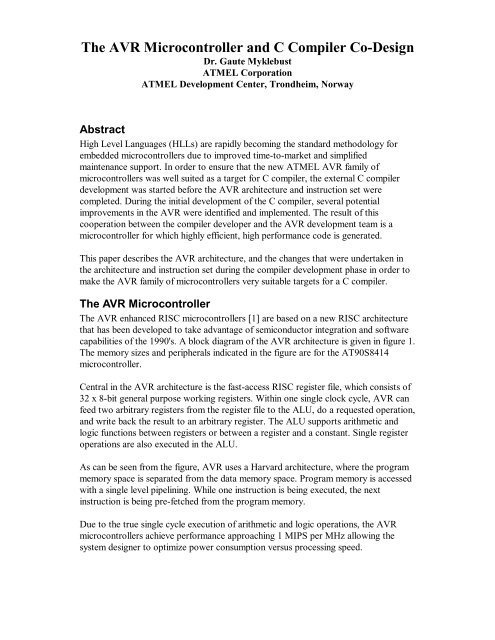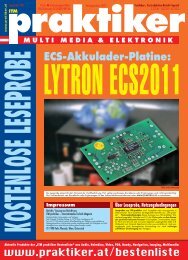The AVR Microcontroller and C Compiler Co-Design
The AVR Microcontroller and C Compiler Co-Design
The AVR Microcontroller and C Compiler Co-Design
You also want an ePaper? Increase the reach of your titles
YUMPU automatically turns print PDFs into web optimized ePapers that Google loves.
<strong>The</strong> <strong>AVR</strong> <strong>Microcontroller</strong> <strong>and</strong> C <strong><strong>Co</strong>mpiler</strong> <strong>Co</strong>-<strong>Design</strong><br />
Dr. Gaute Myklebust<br />
ATMEL <strong>Co</strong>rporation<br />
ATMEL Development Center, Trondheim, Norway<br />
Abstract<br />
High Level Languages (HLLs) are rapidly becoming the st<strong>and</strong>ard methodology for<br />
embedded microcontrollers due to improved time-to-market <strong>and</strong> simplified<br />
maintenance support. In order to ensure that the new ATMEL <strong>AVR</strong> family of<br />
microcontrollers was well suited as a target for C compiler, the external C compiler<br />
development was started before the <strong>AVR</strong> architecture <strong>and</strong> instruction set were<br />
completed. During the initial development of the C compiler, several potential<br />
improvements in the <strong>AVR</strong> were identified <strong>and</strong> implemented. <strong>The</strong> result of this<br />
cooperation between the compiler developer <strong>and</strong> the <strong>AVR</strong> development team is a<br />
microcontroller for which highly efficient, high performance code is generated.<br />
This paper describes the <strong>AVR</strong> architecture, <strong>and</strong> the changes that were undertaken in<br />
the architecture <strong>and</strong> instruction set during the compiler development phase in order to<br />
make the <strong>AVR</strong> family of microcontrollers very suitable targets for a C compiler.<br />
<strong>The</strong> <strong>AVR</strong> <strong>Microcontroller</strong><br />
<strong>The</strong> <strong>AVR</strong> enhanced RISC microcontrollers [1] are based on a new RISC architecture<br />
that has been developed to take advantage of semiconductor integration <strong>and</strong> software<br />
capabilities of the 1990's. A block diagram of the <strong>AVR</strong> architecture is given in figure 1.<br />
<strong>The</strong> memory sizes <strong>and</strong> peripherals indicated in the figure are for the AT90S8414<br />
microcontroller.<br />
Central in the <strong>AVR</strong> architecture is the fast-access RISC register file, which consists of<br />
32 x 8-bit general purpose working registers. Within one single clock cycle, <strong>AVR</strong> can<br />
feed two arbitrary registers from the register file to the ALU, do a requested operation,<br />
<strong>and</strong> write back the result to an arbitrary register. <strong>The</strong> ALU supports arithmetic <strong>and</strong><br />
logic functions between registers or between a register <strong>and</strong> a constant. Single register<br />
operations are also executed in the ALU.<br />
As can be seen from the figure, <strong>AVR</strong> uses a Harvard architecture, where the program<br />
memory space is separated from the data memory space. Program memory is accessed<br />
with a single level pipelining. While one instruction is being executed, the next<br />
instruction is being pre-fetched from the program memory.<br />
Due to the true single cycle execution of arithmetic <strong>and</strong> logic operations, the <strong>AVR</strong><br />
microcontrollers achieve performance approaching 1 MIPS per MHz allowing the<br />
system designer to optimize power consumption versus processing speed.
Figure 1: <strong>The</strong> <strong>AVR</strong> Architecture (AT90S8414)<br />
<strong>The</strong> Architecture allows for up to 8M Bytes program memory, <strong>and</strong> 16MBytes of Data<br />
memory, <strong>and</strong> covers a wide range of applications.<br />
Fine tuning <strong>AVR</strong><br />
<strong>The</strong>re are several advantages in using HLLs in stead of using Assembly language when<br />
developing microcontroller applications. <strong>The</strong>re has, however, traditionally been one<br />
major disadvantage: the size of the code increases. <strong>The</strong> <strong>AVR</strong> microcontroller was<br />
developed with the C language in mind in order to make it possible to construct a code<br />
efficient C compiler for <strong>AVR</strong>. To improve this feature even more, the development of<br />
the C compiler was started before the architecture <strong>and</strong> the instruction set were<br />
completed. By allowing professional compiler developers at IAR Systems in Sweden<br />
to comment on the architecture <strong>and</strong> instruction set, we were able to make a<br />
microcontroller very well suited for C compiler generated code.<br />
This section describes the modifications that were done in order to tune the<br />
architecture <strong>and</strong> instruction set towards even more towards the C language.
Addressing modes<br />
In order for the compiler to generate efficient code, it is important that the supplied<br />
addressing modes matches the needs of the C language. <strong>The</strong> <strong>AVR</strong> architecture was<br />
originally equipped with two pointer registers. <strong>The</strong>se two pointers could be used for<br />
indirect addressing, indirect addressing with post increment, indirect addressing with<br />
pre-decrement, <strong>and</strong> indirect addressing with displacement, giving good support for<br />
operation on pointers. In addition, there was a paged direct addressing mode for<br />
accessing variables placed in the data memory.<br />
Displacements<br />
<strong>The</strong> indirect addressing mode with displacement is a very useful addressing mode, also<br />
from a C compilers point of view. For example, by setting the pointer to the first<br />
element in a struct, you can reach as far in the struct as the displacement allows<br />
you, without having to change the 16-bit pointer. <strong>The</strong> indirect addressing with<br />
displacement mode is also frequently used for accessing variables placed on the<br />
software stack. Function parameters, <strong>and</strong> autos are often placed on the software stack,<br />
<strong>and</strong> can be read <strong>and</strong> written without having to change the pointers. <strong>The</strong> displacement<br />
addressing is also very useful in addressing elements in an array.<br />
Even though the displacement mode is very useful in many cases, there was a problem<br />
with the reach of this addressing mode. Originally, the displacement was limited to 16<br />
locations, whereas the displacement needed in real applications often exceeds this<br />
number. In the case where the location can not be reached by the displacement mode, a<br />
new pointer needs to be loaded. To exp<strong>and</strong> the reach of the displacement mode, we<br />
needed to change other parts of the instruction set to get enough coding space. At the<br />
same time, we were informed that the paged direct accessing mode was difficult to use<br />
from the compilers point of view. By removing the paged direct addressing mode,<br />
space was made available for exp<strong>and</strong>ing the displacement to 64 locations, which is<br />
large enough to meet most dem<strong>and</strong>s for indirect addressing. <strong>The</strong> paged direct<br />
addressing mode was changed to a two word unpaged direct addressing mode, see<br />
below.<br />
<strong>The</strong> number of memory pointers<br />
<strong>The</strong> <strong>AVR</strong> microcontrollers were originally equipped with two 16-bit memory pointers.<br />
From a C <strong><strong>Co</strong>mpiler</strong>s point of view, one of these pointers must be used as a dedicated<br />
software stack, leaving only one memory pointer for general usage. In many cases, you<br />
need to copy memory from one area to another. Having only one memory pointer, you<br />
would need to read one byte, set the pointer to the destination area, write the byte <strong>and</strong><br />
then set the pointer back to the source data area. By including a third memory pointer<br />
(with reduced functionality), data can be copied from one memory area to another<br />
memory area without having to set the pointers. By exploiting the post increment<br />
mode of pointer addressing very efficient loops can be constructed for this purpose<br />
(assuming Z points to first byte in source, X points to first byte in destination):<br />
LDI R16,0x60 ; Load byte count<br />
loop: LD R17,Z+ ; Load byte, increment pointer<br />
ST X+,R17 ; Store byte, increment pointer<br />
SUBI R16,1<br />
; Decrement counter
BRNE loop ; Branch if more bytes<br />
<strong>The</strong> possibility to post-increment <strong>and</strong> pre-decrement also makes the pointers very<br />
efficient for implementing stacks. This is of course utilized in the software run-time<br />
stack.<br />
Direct addressing<br />
As described in the displacement section, we originally had a paged direct addressing<br />
mode which was difficult <strong>and</strong> inefficient to use by the compiler. Since we needed<br />
coding space for an increased displacement, the paged direct addressing mode was<br />
removed. It is, however, inefficient not having any direct addressing mode, since we in<br />
some cases need to access variables placed in the data memory area. Especially when<br />
dealing with static characters, the code overhead will be large (50%), since<br />
static variables needed to reside in data memory <strong>and</strong> can not automatically be<br />
placed in registers. In order to overcome this problem with inefficient code, we<br />
decided to include unpaged direct addressing instructions taking a 16-bit address,<br />
making it possible to address 64KByte data memory in one instruction. In order to<br />
access such a large amount of memory, these instructions had to be two 16-bit words.<br />
Using this addressing mode is more efficient than using pointers when the number of<br />
bytes to be accessed is small, for instance when a character is read. For larger areas, it<br />
may still be more effective to use indirect addressing (see example below).<br />
Loading of a character:<br />
Indirect addressing (6 Bytes):<br />
Direct addressing (4 Bytes):<br />
LDI R30,LOW(CHARVAR) LDS R16,CHARVAR<br />
LDI R31,HIGH(CHARVAR)<br />
LD R16, Z<br />
Loading of a long integer:<br />
Indirect addressing (12 Bytes)<br />
Direct addressing (16 Bytes)<br />
LDI R30,LOW(LONGVAR) LDS R0,LONGVAR<br />
LDI R31,HIGH(LONGVAR) LDS R1,LONGVAR+1<br />
LDD R0,Z LDS R2,LONGVAR+2<br />
LDD R1,Z+1 LDS R3,LONGVAR+3<br />
LDD R2,Z+2<br />
LDD R3,Z+3<br />
Zero flag propagation<br />
In order to make conditional branches, a number of the instructions manipulates the<br />
<strong>AVR</strong> status register, which consists of a number of flags. A conditional branch<br />
instruction following such an instruction, will branch or not branch, depending on the<br />
settings of these flags. <strong>The</strong> arithmetic instructions manipulate the flags, making it<br />
possible to check whether a number A is smaller than, equal to or greater than another
number B. When the numbers in question are eight bit numbers, there are no problems,<br />
since all the flags are depending on the flag setting done by one instruction only. When<br />
using 16 or 32 bit numbers, which is common in the C language, the problem is<br />
somewhat more tricky, since a 32 bit subtraction, for instance, is calculated as 4<br />
consecutive 8 bit subtractions, <strong>and</strong> after each subtraction, a new set of flags is<br />
generated.<br />
For propagating the carry flag, most processors have incorporated instructions which<br />
takes into account the previous setting of the carry flag, for instance SBC - subtract<br />
with carry where SBC A,B means A=A minus B minus Carry-bit. <strong>The</strong>re is however,<br />
another flag that needs to be propagated in order to be able to correctly do all<br />
conditional branches. This is the Zero flag.<br />
Example:<br />
A=R3:R2:R1:R0,<br />
B=R7:R6:R5:R4<br />
We want to subtract B from A <strong>and</strong> jump to a specific location if A is equal to B. If the<br />
Zero flag is only dependent on the last arithmetic instruction, the following sequence<br />
will not do:<br />
SUB R0,R4<br />
SBC R1,R5<br />
SBC R2,R6<br />
SBC R3,R7 ; R3=R7 => Zero flag set<br />
BREQ destination<br />
since the flag settings present during the BREQ instruction only depends on the flags<br />
set by the last SBC instruction. If the most significant bytes are equal, the Zero flag<br />
will be set <strong>and</strong> the branch will be done, even if the 32 bit numbers are not equal. This<br />
problem also applies to other conditional branches.<br />
<strong>The</strong>re are two ways of overcoming this problem. One is to save the flags produced by<br />
each instruction, <strong>and</strong> then check all the zero flags after the fourth subtraction is done.<br />
<strong>The</strong> other, more elegant way, is to propagate the zero flag in the carry instructions like<br />
this:<br />
Znew =Not(R7) AND<br />
Not(R6) AND<br />
...<br />
Not(R0) AND<br />
Zold<br />
By propagating the Zero flag in this way, all conditional branches can be done after the<br />
final subtraction, since all the rest of the interesting flags (overflow <strong>and</strong> positive flag)<br />
are only dependent on the most significant byte.<br />
Tuning the arithmetic instructions<br />
Some tuning of the arithmetic instructions was also done. This tuning is described<br />
here.
Addition <strong>and</strong> subtraction<br />
We originally planned to have both addition <strong>and</strong> subtraction with eight bit constants -<br />
ADDI <strong>and</strong> SUBI. We did, however, not have space for having Carry instructions with<br />
constants, so a 16 bit add with a constant would look like this:<br />
ADDI R16,0x44<br />
LDI R18,0x55<br />
ADC R17,R18<br />
An addition can, however, be realized as a subtraction <strong>and</strong> vice versa, so it was<br />
decided that the ADDI instruction should be changed to a SBCI instruction, thereby<br />
enabling 16 <strong>and</strong> 32 bit additions <strong>and</strong> subtractions with constants, thereby reducing<br />
code size substantially in 16 <strong>and</strong> 32 bit cases <strong>and</strong> with no code size penalty for 8 bit<br />
cases.<br />
<strong>Co</strong>mpare with constant<br />
<strong>The</strong> original instruction set did not include any instruction for comparing a register<br />
with a constant. In order to do such an operation, a constant had to be loaded into a<br />
register, <strong>and</strong> then the two registers could be compared. This is a very frequently used<br />
operation, <strong>and</strong> as a result of removing one of the original addressing modes, space was<br />
found in the instruction coding for this instruction.<br />
Non-destructive comparison<br />
If you want to compare two eight bit numbers, then this can be done by using a<br />
compare instruction. If you want to compare 16 or 32 bit numbers however, you<br />
would originally have to compare use subtraction with carry in order to get the flag<br />
setting right. <strong>The</strong> problem with using subtraction with carry is that it overwrites the<br />
contents of one of the numbers you are comparing. One solution to this problem is to<br />
copy this number over to new locations before subtracting, but such a solution will<br />
require more instructions <strong>and</strong> will use more registers. In order to overcome this<br />
problem, we decided to include a <strong>Co</strong>mpare with carry instruction, thereby enabling<br />
nondestructive comparison of numbers larger than eight bit.<br />
<strong>Co</strong>nclusions<br />
We have constructed a microcontroller well suited for High Level Languages. <strong>The</strong><br />
final tuning of the microcontroller done in cooperation with the C compiler developer<br />
has given an additional improvement to the design. Evaluating the code generated from<br />
the compiler, it turns out that the modifications that were done after discussions with<br />
the compiler developer were successful, as the generated code exploits the<br />
improvements frequently.<br />
References<br />
[1] ATMEL <strong>Co</strong>rporation. <strong>AVR</strong> Enhanced RISC <strong>Microcontroller</strong>s Data Book. May 1996.
















